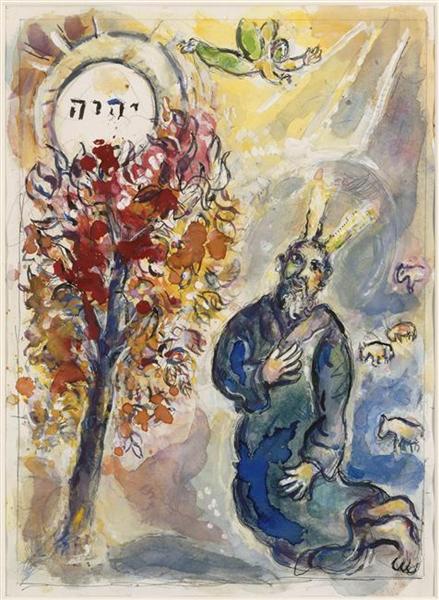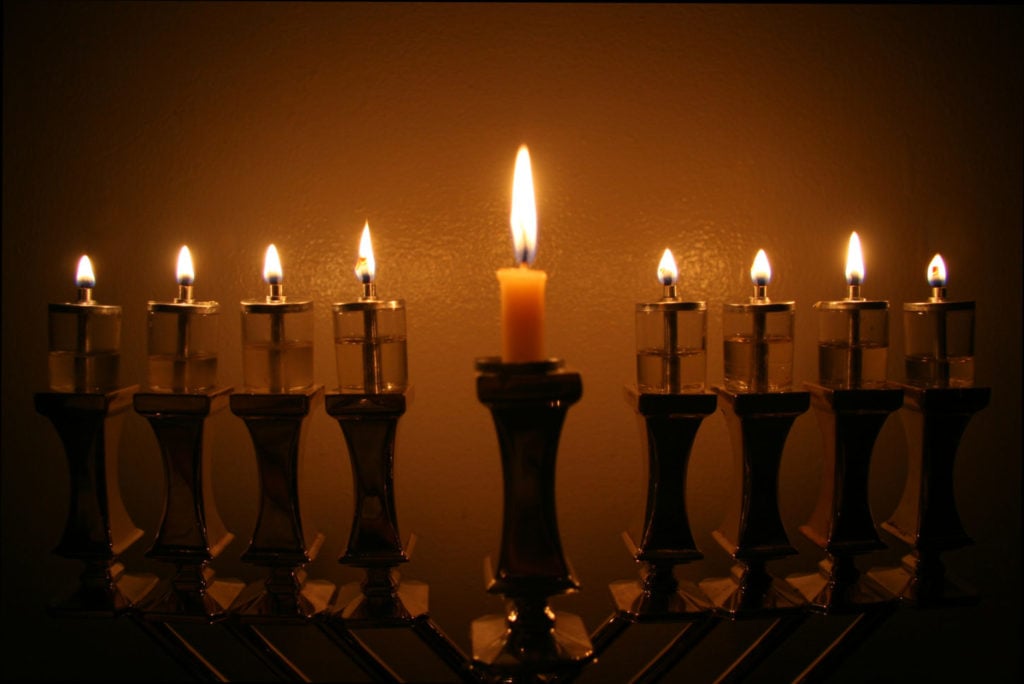As I wrote in my post, Schrödinger Menorah: Burning And Not Burning, the Lubavitcher Rebbe, Rabbi Menachem Mendel Schneerson, explains the miracle of Chanukah as a paradox of the menorah (chanukiah or hanukkiah) burning and not burning, thereby embodying the absolute nature of G‑d, who is not limited by His infinity and combines all possibilities including the infinitude (ko’ach bli gvul) and the finitude (ko’ach hagvul). The notion of the menorah burning and not burning easily lends itself to be cast in terms of the quantum superposition of states of burning and not burning. I couldn’t help myself to call it the Schrödinger Menorah.
There a couple of problems, however, with this idea. Firstly, as the Rebbe wrote in 1971 in a letter to the editor of the Journal of the Association of Orthodox Jewish Scientists,
“The idea of miracles implies a change in a fixed order and not the occurrence of a least probable extent.”
In other words, the Rebbe maintained that an event that the Torah classifies as a miracle is not a natural phenomenon permitted by the laws of physics, however improbable, but a departure from the laws of nature. The state of superposition is a central feature of quantum mechanics and is entirely natural. So, strictly speaking, there is nothing unnatural about the oil burning and not burning, i.e., being in a state of superposition of two states: burning and not burning. No laws of physics are broken here – hence this cannot be a miracle worthy of celebration. (Needless to say, I do not mean to imply that a macroscopic menorah is actually in the quantum-mechanical state of superposition that exists in the microscopic world of subatomic particles. I use this analogy in a metaphorical sense, to illustrate the quantum logic of the Torah.)
Moreover, a careful reader will undoubtedly raise an objection to the quantum-mechanical metaphor comparing the Chanukah menorah with the Schrödinger cat. After all, the Schrödinger cat is in a state of superposition of two states—alive and dead—only so long as it is in a closed box hidden from the eyes of the observer. As soon as the observer opens the lid and peeks inside the box, the observer immediately collapses the wavefunction and reduces the superposition state of the poor feline to a single state, consequently finding the cat either alive or not alive. The Temple Menorah that was lit by the High Priest on the first night of rededication of the Temple (Bet HaMikdash) was obviously observed by the High Priest himself and all other people present during the ceremony. If the oil was in a state of superposition of burning and not burning, why all these observers did not collapse the wavefunction and reduce the superposition state of the oil to a single state of either burning or not burning?
I submit to you that the miracle of Chanukah was not in the oil being in the state of superposition of burning and not burning—there is nothing miraculous about that—but it was in the fact that the observers miraculously failed to collapse the wavefunction of the oil, which allowed it to remain in the state of superposition for eight days, notwithstanding the act of observation (and natural decoherence) that typically collapses the wavefunction. This phenomenon clearly violates (metaphorically speaking) the laws of physics meeting the definition of a ness—a miracle.
We find a similar occurrence in the Torah, in the story of the Burning Bush (See my post, Moses – the First Scientist):
And the angel of G‑d appeared to him in a flame of fire out of the midst of a thorn-bush; and he looked, and, behold, the bush burned with fire, but the bush was not consumed. (Exodus 3:2-3)
We can say here too that the bush was in a state of superposition of two states: burning and not burning. Indeed, “the bush burned with fire, but the bush was not consumed”— the bush was burning and not burning just as the olive oil in the Temple Menorah.
If we really believe that quantum logic is implicit in the Torah (as I’ve been laboring to demonstrate on this blog), we must conclude that Moses knew the logic of quantum mechanics, at least, on some conceptual level. If this is the case, how are we to understand the next verse?
And Moses said: “I must turn aside, and investigate this wondrous phenomenon, why the bush is not burnt.”

If Moses understood the concepts of quantum physics, the state of superposition was no news to him. What did he find so wondrous about this phenomenon? We must conclude that Moses was perplexed not by the state of superposition of burning and not burning, but by the fact that he was able to look at it without collapsing the wavefunction! This was indeed a miracle requiring divine intervention.
There is a famous question with respect to the Schrödinger cat: if it is the knowledge (da’at) of the observer that collapses the wavefunction of the cat, G‑d surely sees and knows the state of the cat—why doesn’t G‑d’s knowledge collapse the cat’s wavefunction? The answer to this question is the same as the answer to another question, how can we maintain free will if G‑d knows the future? As it is explained in Chasidic philosophy, G‑d’s knowledge, called da’at elyon (the “higher knowledge”) does not interfere with our knowledge, called da’at tachton (the “lower knowledge”). The higher knowledge and the lower knowledge exist, as it were, in parallel universes. Therefore, only da’at tachton (human knowledge) can collapse the wavefunction.
Only on very rare occasions, G‑d chooses to break the laws of nature created by Him, as an act of divine benevolence. One such example is the story of Sotah, a suspected adulteress, who secludes herself with a man other than her husband in a room with no witnesses. We don’t know what happened in that room. Therefore, the woman puts herself in a state of superposition of being defiled through adultery and being pure (i.e., innocent). In this case, to save the woman, G‑d reveals His higher knowledge of what has transpired in the room through the ritual of bitter waters thereby collapsing the wavefunction of the woman. (See my posts, Sotah – Suspected Adulteress as a Schrödinger Cat and G‑d Collapses the Sotah’s Wavefunction).

In other cases, such as burning bush and Chanukah Menorah, the opposite takes place: instead of collapsing the wavefunction Himself (as He did for Sotah), G‑d prevents human observers from collapsing the wavefunction—Thou shall not collapse the wavefunction!—resulting in the miracles of the burning bush and Chanukah.
In this sense, the story of Chanukah menorah, where G‑d prevents us from collapsing the wavefunction, is a mirror image of the story of Sotah, where G‑d Himself causes the collapse of the wavefunction. Perhaps it is for this reason, on Chanukah we celebrate a righteous Jewish woman, Judith (Yehudit), who saved the Jews by also secluding herself with a man, Nicanor (Holofernes), a general of the Antiochus’ (Nebuchadnezzar’s) army, to inebriate him and cut off his head. I suppose this is one way to collapse someone’s wavefunction…

The miracle of Chanukah is caused by Omnipotent G‑d Who broke His own laws of nature and, through divine intervention, prevented observers from collapsing the wavefunction of the oil in the Temple Menorah. The miracle is not in burning and not burning; the miracle is rather in looking and not collapsing.
Celebrating Chanukah with latkes and doughnuts, I pray for yet another miracle – looking and not eating. But that requires infinite will-power, which I so sorely lack. It will take nothing short of Divine intervention! Pass me some latkes, please…


I find your essays extremely interesting. They show a quantum leap in thinking, putting things separatedly and together and then some systhesis.
May Hashem continue giving you strength and the spiritual drive to continue your very special work!
Hayim
Bet El
Thank you very much for your kind words and blessings. Lol mevarach — yitbarach! Chanukah sameach!
Alex
You interpret the Rebbe’s comment to mean that a miracle is something that occurs in a violation of the laws of nature. I do not think that this is what a miracle is – for instance, to split the sea during the Exodus, Hashem “caused the sea to go back by a strong east wind all the night”. This is a natural cause, albeit an unusual occurrence, but the key here is that Hashem caused it personally at that moment to occur, when normally it would not have occurred. But it was not outside the laws of nature. And how could anything be outside the laws of nature, which are Hashem’s laws, since Hashem created nature and this world, and is in fact nature itself. It is certainly impossible that it is anything other than Hashem! Many people of the past would have thought it a miracle that a room fills with light at the mere flick of a switch, or that men can fly in heavy objects. These improbable events occur through physical means, but the creation of these physical means is basically miraculous. Light is in itself a miracle. So is gravity. We just tend to take the physical occurrences that occur all the time for granted. But if it can be done in this world, I don’t think you could call anything outside the laws of nature!
In this instance, I don’t interpret the words of the Rebbe, this is what the Rebbe himself wrote! I quoted him verbatim.
Well, you have one quote here by the Rebbe out of context, so I can’t say for certain what the Rebbe was saying in his letter. You are using this isolated sentence to support your theory. That aside, I wonder why you completely ignore anything else I said in my previous comment. I still contend that nothing that happens in nature is outside of nature, by its very definition. I believe that it is Hashem’s direct intervention within the laws of nature that constitutes what we call a miracle. Also, a further contention that I have with this article of yours is that you wonder why Moses questioned a bush that burned while not burning, if he was in fact acquainted with quantum physics. Is the bush then on the level of quantum physics? It is on the level of every day physics, which we know is the result of many occurrences on a quantum level that then are not manifest as such at the physical level that we live in. So then your statement that the Menorah was also on the level of quantum physics also puzzles me. And the comment about the Sotah being a state where Hashem collapses a waveform – can’t we see blood or bodily fluid using a “black light”? This is evidence of physical things that the human eye can’t readily see. There are chemical tests to show that certain substances are in the blood. Everything is known by Hashem and there are only some ways that things are revealed to the eyes of humans. The Sotah test is one of these things, it is Hashem’s directions for revealing something that is already there.